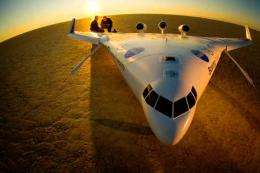No mere flight of fancy: Engineering professor working on experimental plane that could transform air travel

As a child, Robert Liebeck loved tinkering with model airplanes. The UC Irvine adjunct professor of mechanical & aerospace engineering is still at it — but now he's working on a much different kind of model, one that could revolutionize air travel.
Called the blended wing body, the concept results in aircraft that look more like sleek manta rays than today's tube-and-wing jets. A BWB plane would burn about 20 percent less fuel than conventional planes, and because its engines mount high on the back of the aircraft, it would be an estimated 50 decibels quieter.
"It could operate out of John Wayne Airport 24 hours a day," says Liebeck, who has been developing the BWB as a senior fellow at the Boeing Company for more than 20 years.
While he admits it could be at least another decade before a BWB plane rolls off the runway, anyone who thinks it's a pie-in-the-sky project doesn't know Liebeck. In aeronautics circles, he's kind of a top gun.
A member of the National Academy of Engineering, he's earned the most prestigious prizes in his field, including the American Society of Mechanical Engineers' 2005 Spirit of St. Louis Medal (past winners include astronaut Neil Armstrong); the 2010 Daniel Guggenheim Medal; and, most recently, the 2012 Brigadier General Charles E. "Chuck" Yeager International Aeronautical Achievements Award.
"I think the reason I've won these awards is I happen to work on a couple of things that are tangible," says the self-effacing Liebeck.
One of those tangible things is the high-lift airfoil that bears his name. "Airfoils are what you get when you look at the cross-sectional shape of a wing — if you cut through it to see the design," he explains.
In the late 1960s, while working on his doctorate at the University of Illinois at Urbana-Champaign, Liebeck showed how to reshape airfoils to get maximum lift.
"I was so lucky," he says. "I continued developing these, and pretty soon they were calling them 'Liebeck airfoils.'" They proved to be the most efficient wing design ever created.
Originally, Liebeck applied them to spy planes and other "black world stuff" he can't discuss. Eventually, the airfoils gained widespread use in subsonic aircraft, and he began utilizing them to make race cars and boats go faster.
"I wound up putting them on the race car that won the Indianapolis 500 in 1975, the yacht that won the 1991 America's Cup, and the winning World Aerobatic Championships airplane in 1988. It was victory on land, at sea and in the air," he quips.
After exhausting ideas for the airfoils, Liebeck turned his attention to the BWB, a joint venture by Boeing and NASA that he and two co-developers first envisioned in 1988.
"The three of us attended a NASA workshop for aerospace companies and academics, and we sketched out this airplane," Liebeck recalls. "The folks at NASA were struck. Later I got a call from them asking, 'Hey, for $93,000 can you take a more serious look at this?' So we did."
A cross between a conventional subsonic airplane and a flying wing, the BWB prototype "showed incredible reduction in fuel burn — 20 percent to 30 percent compared to tube-and-wing airplanes," he says. "Those are big numbers."
Liebeck's team built a 21-foot-wingspan experimental BWB aircraft that's made nearly 100 unmanned test flights out of NASA's Dryden Flight Research Center at Edwards Air Force Base.
"It's shown that a tailless configuration works," he says. Their next goal is a manned demonstration with a larger prototype, perhaps the size of a 737. The full-size BWB jet would carry 500 to 600 passengers.
Liebeck works at Boeing while teaching one class a quarter at The Henry Samueli School of Engineering.
"He's world-renowned for his contributions in aerodynamics and aircraft design and instills his vast knowledge in the senior year of the aerospace curriculum," says Dimitri Papamoschou, UCI mechanical & aerospace engineering professor. "It's an outstanding and inspiring educational experience for the students. We're lucky to have him."
Liebeck joined UCI in 2000 after teaching for 24 years at USC. "It was an easy decision. I could see this building from my house in Turtle Rock [Irvine]," he says, referring to Engineering Gateway. He's also a professor at the Massachusetts Institute of Technology — flying to the Cambridge, Mass., campus four or five times a year.
"Teaching is the best job there is," Liebeck says. "Even if I've given a lousy lecture, when I drive home, I feel I've done something good."
A licensed pilot, he encourages his students to take flying lessons and at least experience a solo flight if they're interested in aircraft design. "I can't fathom working on this stuff and not knowing how to fly," he says.
In addition to his classroom duties, Liebeck advises UCI engineering students who enter Design/Build/Fly, a national radio-controlled-airplane competition hosted by the American Institute of Aeronautics & Astronautics.
Last June, he marked his 50th year with Boeing (he was hired while still in college) and has no plans to retire. He wants to continue teaching and see the BWB jet get off the ground.
"I keep working because I love it," Liebeck says. "For a guy who got into aeronautics because he used to play with airplane models, I have the coolest model airplane there is."
Provided by University of California, Irvine




















